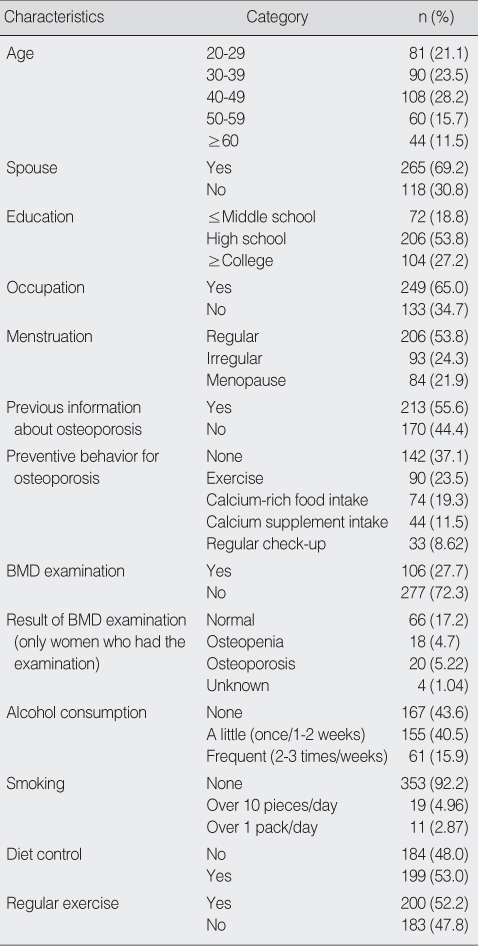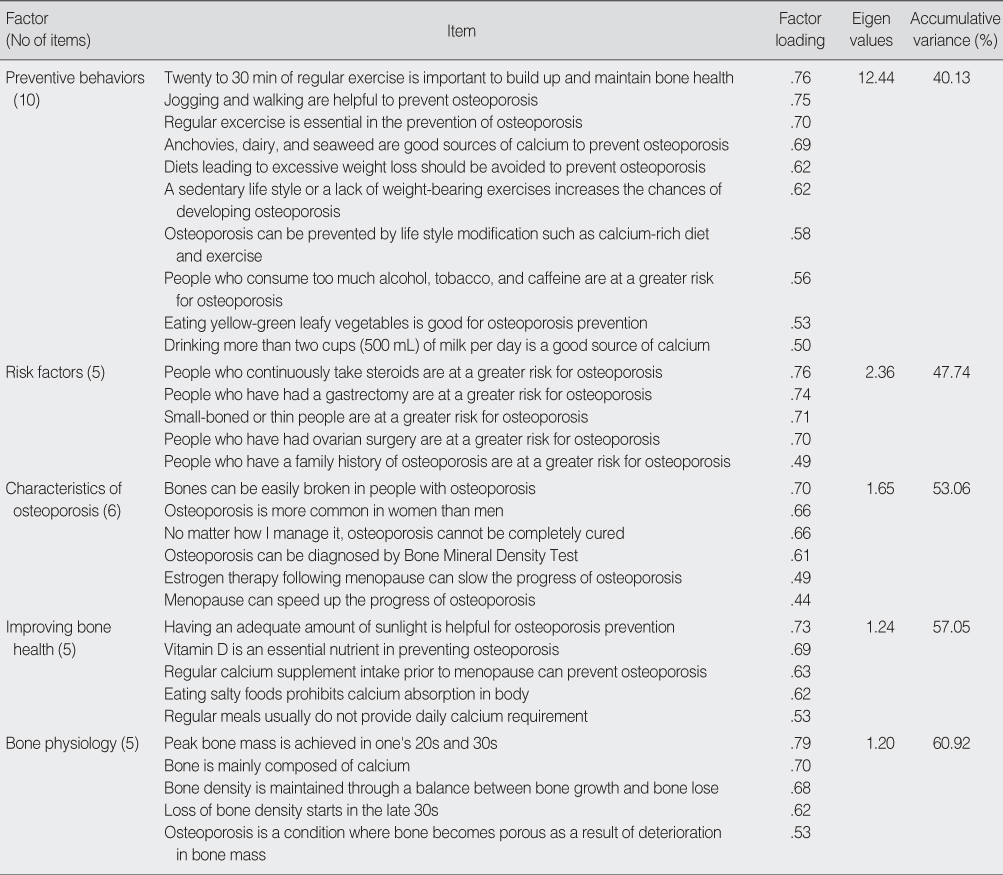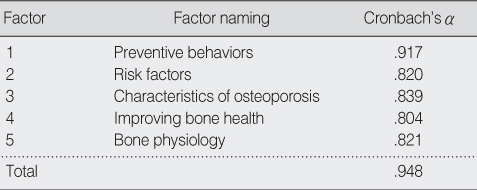Articles
- Page Path
- HOME > J Korean Acad Nurs > Volume 38(6); 2008 > Article
-
Original Article
- Development of an Osteoporosis Awareness Scale for Women
- Euysoon Choi, Juhu Kim, Miyoung Chung, Kyunghye Hwang
-
Journal of Korean Academy of Nursing 2008;38(6):813-821.
DOI: https://doi.org/10.4040/jkan.2008.38.6.813
Published online: December 31, 2008
1Professor, College of Nursing, Catholic University, Seoul, Korea.
2Associate Professor, Graduate School of Education, Ajou University, Suwon, Korea.
3Assistant Professor, Department of Nursing, Dong-U College, Sokcho, Korea.
4Unit Manager, Department of Nursing, Catholic Medical Center, Seoul, Korea.
- Address reprint requests to: Choi, Euy Soon. College of Nursing, Catholic University, 505 Banpo-dong, Seocho-gu, Seoul 137-701, Korea. Tel: 82-2-590-1279, Fax: 82-2-590-1297, eschoi@catholic.ac.kr
• Received: May 19, 2008 • Accepted: November 7, 2008
Copyright © 2008 Korean Society of Nursing Science
Abstract
-
Purpose
- This study was conducted to develop an instrument measuring awareness of osteoporosis.
-
Methods
- The process included construction of a conceptual framework, generation of 86 preliminary items, verification of content validity, selection of secondary items, verification of construct validity and extraction of final items. The 86 items were reviewed for content validity by two groups of experts and were tested to evaluate inter item correlation coefficient by two groups of adult women. From June to August 2007, data were collected from 383 adult women who lived in Seoul and provinces in Korea. Data were analyzed by performing item analysis, Varimax factor analysis and Cronbach's alpha.
-
Results
- There were 31 items in the final instrument categorized into 5 factors. The factors were labeled as "preventive behaviors (10 items)", "risk factors (5 items)", "characteristics of osteoporosis (6 items)", "improving bone health (5 items)", and "bone physiology (5 items)". Cumulative percent of variance was 60.92% and eigen values ranged from 1.20 to 12.44. Cronbach's alpha was .948 and ranged from .804 to .917.
-
Conclusion
- Validity and reliability of the scale are confirmed in this study showing its utility for measuring awareness of osteoporosis for women. Utilization of the scale will also contribute to designing an appropriate prevention program for osteoporosis.
This study was supported in part by the alumni association of the Catholic University, College of Nursing.
- 1. Ailinger RL, Harper DC, Lasus HA. Bone up on osteoporosis: Development of the Facts on Osteoporosis Quiz. Orthopedic Nursing. 1998;17(5):66–73.PubMed
- 2. Ali NS, Bennett SJ. Postmenopausal women. Factors in osteoporosis preventive behaviors. Journal of Gerontological Nursing. 1992;18(12):23–32.ArticlePubMed
- 3. Barbara HM. Statistical methods for health care research. 2001;4th ed. Philadelphia, NY, Lippincott-Williams and Wilkins.
- 4. Berarducci A, Lengacher CA, Keller R. The impact of osteoporosis continuing education on nurses' knowledge and attitudes. The Journal of Continutin Education in Nursing. 2002;33:210–216.Article
- 5. Black JM, Hacks JM, Keene AM. Adult health nursing. 2007;Seoul, Jung Dam Media Publishing.
- 6. Ferketich S. Focus on psychometrics. Aspects of item analysis. Research in Nursing & Health. 1991;14:165–168.Article
- 7. Gambert SR, Schltez BM, Hamdy RC. Osteoporosis. Clinical features, prevention and treatment. Endocrinology and Metabolism Clinics of North America. 1995;24:317–371.ArticlePubMed
- 8. Grady IJ. Factors influencing stage of change and osteoporosis prevention behaviors. 2000;PA, USA, University of Pittsburgh. Unpublished doctoral dissertation.
- 9. Kim BS. Menopause women and exercise. Korean Journal of Health Promotion and Disease Prevention. 2001;1:1–7.
- 10. Kim K, Horan M, Gendler P. Osteoporosis knowledge tests, osteoporosis health belief scale and osteoporosis self-efficacy sale. 1991;Allendale, MI, Grand Valley State University Press.
- 11. Kim MH, Kim MS. A study on the relationships between knowledge about osteoporosis and cognitive factors in middle-aged women. Korean Journal of Women Health Nursing. 2005;11:52–57.ArticlePDF
- 12. Korea Statistical Information Service data. Health Social Welfare Statistics. 2002;December;Retrieved May 30, 2007. from http://www.kosis.kr./domestic/theme/2001_index.jsp htm# National.
- 13. Lee HS, Kim Y. Hangul SPSS 10.0 guide for beginner. 2002;Seoul, Bomunsa Publishing.
- 14. Lynn MR. Determination and quantification of content validity. Nuring Research. 1986;35:382–385.
- 15. Ministry of Health and Welfare. Identification of characteristics and pathogenesis of osteoporosis in Korea and search for new drugs. 2005;Seoul, Author. Report of Health Medicine Technical Infra Development Project.
- 16. National Osteoporosis Foundation data. Fast facts on osteoporosis. 2008;Retrieved March 30, 2008. from http://www.nof.org/osteoporosis/diseasefacts. htm# National.
- 17. Pande KC, de Takats D, Kanis JA, Edwards V, Slade P, McCloskey EV. Development of a questionnaire (OPQ) to assess patient's knowledge about osteoporosis. Maturitas. 2000;37:75–81.ArticlePubMed
- 18. Sedlak CA, Doheny MO, Jones SL. Osteoporosis Education Programs: Changing knowledge and behavior. Public Health Nursing. 2000;17:398–402.ArticlePubMed
- 19. Shin KR, Kang YM. A study on the relationships between osteoporosis knowledge, self-efficacy and health belief of woman in an island. Journal of Korean Academy of Nursing. 2002;32:89–99.
- 20. Sin SJ, Shin KR, Yi HR, Ju SK. Knowledge, health belief, and self-efficacy related osteoporosis. Journal of Korean Academy of Nursing. 2005;35:850–857.PubMed
- 21. Song HR. Effects of the knowledge, health belief, and self-efficacy of osteoporosis on calcium intake behavior for postmenopausal osteoporosis patients. 2007;Daejeon, Cheonnam National University. Unpublished master's thesis.
- 22. Sun KS. The effect of web-based osteoporosis prevention program on the osteoporosis knowledge, self efficacy, health belief, stage of change in female college students. 2003;Gwangju, Cheonnam National University. Unpublished doctoral dissertation.
- 23. Werner P. Knowledge about osteoporosis: Assessment, correlations and outcomes. Osteoporosis International. 2005;16:115–127.PubMed
- 24. Winzenberg TM, Oldenburg B, Frendin S, Jones G. The design of a valid and reliable questionnaire to measure osteoporosis knowledge in women: The Osteoporosis Knowledge Assessment Tool (OKAT). BMC Musculoskeletal Disorders. 2003;24:4–17.
- 25. World Health Organization. WHO study group on assessment of fracture risk and its application to screening for postmenopausal osteoporosis. Assessment of fracture risk and its application to screening for postmenopausal osteoporosis. 1994;Geneva, Switzerland, Author. Technical Report No. 843.
- 26. Yang SA. A study on the relationships between osteoporosis knowledge, self-efficacy and health belief of women in urban city. Korean Women's Health. 2005;6:19–44.
REFERENCES
Figure & Data
REFERENCES
Citations
Citations to this article as recorded by 

- Osteoporosis Awareness and Effecting Factors: A Descriptive Cross-Sectional Study
Oğuzhan Gökalp, Çiğdem Kaya, Yılmaz Kaya
Turkish Journal of Osteoporosis.2024; 30(3): 149. CrossRef - Assessing osteoporosis awareness and knowledge levels of Turkish multiple sclerosis patients: an observational study
Mustafa Hüseyin Temel, Beril Taşdelen, Serkan Demir, Emre Ata
Archives of Osteoporosis.2024;[Epub] CrossRef - The Comparison of Osteoporosis Knowledge and Awareness Levels of Patients with Hypothyroidism and Hyperthyroidism
Sevil Karagül, Işıl Fazilet Kartaloğlu
Turkish Journal of Osteoporosis.2023; 29(2): 117. CrossRef - Development of the Osteoporosis Self-Care Scale: Based on the Middle-Range Theory of Self-Care for Chronic Illness
Young Joo Seo, Heeyoung Oh
Korean Journal of Adult Nursing.2022; 34(2): 137. CrossRef - The Effects of a Group Educational Intervention on the Prevention of Osteoporosis in Breast Cancer Patients
Bong Hae Ma, Chai-Soon Park, Hee Chong Baek
Journal of Korean Academy of Community Health Nursing.2015; 26(4): 398. CrossRef - An Equation Model Development and Test based on Health Belief Model Regarding Osteoporosis Prevention Behaviors among Postmenopausal Women
Hyun-Jung Jang, Sukhee Ahn
Korean Journal of Adult Nursing.2015; 27(6): 624. CrossRef - A Study on the Level of Awareness and Self-Efficacy of Osteoporosis in Young Women
Euysoon Choi, Ju Young Lee
Korean Journal of Women Health Nursing.2010; 16(2): 204. CrossRef - Study of the Level of Osteoporosis Awareness among Women Dwelling in Urban Area
Miyoung Chung, Kyunghye Hwang, Euysoon Choi
Korean Journal of Women Health Nursing.2009; 15(4): 362. CrossRef
Development of an Osteoporosis Awareness Scale for Women
Development of an Osteoporosis Awareness Scale for Women
Demographic and Osteoporosis related Characteristics of Participants (N=383)
BMD=Bone mineral density test.
Factor Analysis of 31 Items
Reliability Scores for Final Factors (N=383)
Table 1
Demographic and Osteoporosis related Characteristics of Participants (N=383)
BMD=Bone mineral density test.
Table 2
Factor Analysis of 31 Items
Table 3
Reliability Scores for Final Factors (N=383)
 KSNS
KSNS
 E-SUBMISSION
E-SUBMISSION



 Cite
Cite

